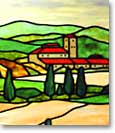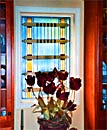Frequently Asked Questions: Stained Glass Fabrication

With its ability to color and sculpt light into everchanging designs, stained glass will bring elegance, period style and spirituality to your space. Durable and affordable, it can add value to a home, refinement to commercial construction and a devotional air to any sanctuary.
Understanding how to recognize and commission quality stained and leaded glass is essential. Here are answers to guide you on how best to examine, commission and enjoy your new installation. Also see our glass restoration FAQ, or contact us with any questions.
What is the process for commissioning new work?

Initially, we’ll need to know where the piece will be installed, the dimensions and the type of design you have in mind. You can either provide pictures or examples of a desired style, or ask us to propose original designs. Ideally, we’d like to meet you and see the space, to better understand the architecture, personality, color scheme, sun exposure and so on.
From there, we’ll draw thumbnail sketches for your approval, which are then expanded into scale drawings. Once you’ve chosen a design, we’ll submit glass samples as we create full-fledged drawings and patterns, then move on to actual construction of the window.
Can you match period styles or copy antique windows?

Glass and construction techniques have changed little over the centuries, so designs from any era can be reproduced, often with precisely matching materials. We’ve created new windows in historical styles including Federal, Tudor, Victorian, Art Nouveau, Prairie, Arts & Crafts, Abstract and Modern, and are expert in recreating 1800s European painted glass. We also match antique lead and zinc cames.
In cases where a certain glass is no longer made, we’ll use permanent enamels fired in the kiln to alter glass color or darken glass to match, or we can fuse different kinds of glass together to create the proper color or texture.
Above all, we take pride in designing windows to the individual taste and personality of each client. We enjoy working in different historical and technical styles. Often, in visiting your home or building, we’ll be able to suggest how period and detailing can be echoed and enhanced through glass design. Understanding your desires, inspirations and personal style is the first step in meeting each new design challenge
How can I judge the quality of stained glass?
A properly fabricated window should remain structurally sound for over 100 years. While using high quality materials is important, it’s often construction details that guarantee longevity.
When judging samples, examine the accuracy of assembled components. Some studios create great-looking designs, but when they put the piece together, lines don’t line up, so the glass isn’t fully seated in the lead. Proper soldering is also key. Solder joints should be neat and contact the heart of the lead came, providing the greatest strength. Weak joints lead to loose, rattling glass.
A well-made window will also be cemented. This putty substance goes between the glass and lead came, making the window airtight, waterproof and stable.
Finally, steel support bars or saddle bars and tie-wires should be installed to keep the window from sagging, falling and bulging out. Always consider a studio’s reputation, and examine references and completed work before commissioning new designs.
Can you modify manufactured windows?

Godfrey Muller works with top manufacturers to incorporate stained glass into windows and doors for home construction. Most thermal pane windows can be modified with custom designs fitted between the original layers, combining the elegance of stained, leaded or beveled glass with the convenience of standard windows.
For one manufacturer, we worked with a customer who wanted sidelights in her doorway, but using custom glass the manufacturer could not provide. We were able to rebuild the doorway components with the custom glass to exactly fit the pre-existing design
Can you repurpose old glass no longer in use?

Many times, after buying an old home or remodeling, an owner will be left with antique stained glass that is either damaged or no longer fits the space. This glass can easily be cut down, built up or entirely redesigned for use in new windows, doors, cabinets or even furniture.
Often people buy antique church glass to adapt for their home. We can easily extend the design and size of these windows, adding precisely matching glass. If you have an old window and want to give it a contemporary style, we can reuse the same glass, artfully rearranging the glass and releading to match any decor.
How much does stained glass cost?

The price varies by project and depends on the size of the installation, intricacy of the design, the number of pieces involved and type of glass you select. Installation is also a factor, as some jobs require the rental of scaffolding or a lift.
Simply write or call us with your project description, and we’ll provide you with an estimate. Plus, if you’re working within a specific budget, let us know and we’ll recommend ways to get you what you want at a price you can afford.
